Saba - Hidden Kingdom in the Dutch Caribbean
04/04/09 13:00
April 04, 2009
Ladder Bay
Saba, Dutch Netherlands Antilles
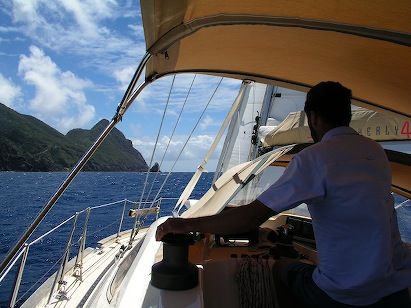
We've just had a wonderful week exploring the island of Saba! Never heard of it? Neither had we. But what an undiscovered treasure this place is! Although it's just a short daysail from the busy touristic island of St. Martin/Sint Maarten, 28 nm to the southwest, it is a remote natural paradise. The only visitors to the tiny yet towering 5 sq mile island of Saba (an extinct volcano) are those seeking quiet remote eco-tourist escapes such as divers, hikers, and a few intrepid cruising sailors.
The main reason for this is that Saba is a challenge to get to. Even Columbus didn't stop here when he sailed by the steeply-sided island in 1493. Today there is an airport but looking at the runway which is precariously positioned on a built-up rocky outcrop near the shoreline you understand why it's considered one of the most challenging runways in the world. Luckily they have some of the best pilots flying in here. There are 4 to 5 flights per day and it makes your heart pound to watch the planes take off or land.
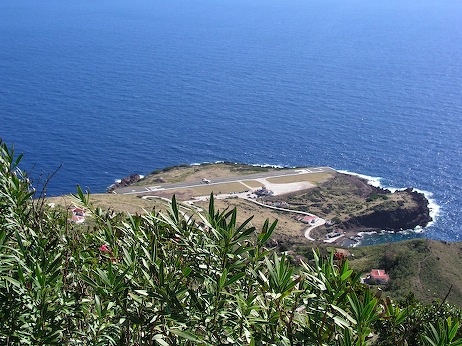
Also, there are no good harbours. There are a couple of anchorages but even on good days they are exposed and a bit rolly. We waited for a forecast of calm days with no northerly swells before sailing over. Even then we were glad we could drop our Southerly 42's swing keel to its full 9 feet draft to keep the boat steady in the anchorage. Recently the Saba Marine Park has installed a series of good solid moorings for visiting sailors which you'll find on the west coast in Wells Bay and Ladder Bay as well as a few on the south coast at Fort Bay to the east of the small ferry dock. This has improved things a bit for the cruising sailor but if you're on one of the moorings in Wells or Ladder Bay, the most protected and desirable anchorages, you still face a rough wet dinghy ride to the town quay 2 nm away in Fort Bay.
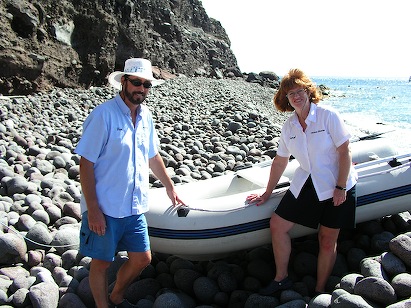
The alternative is to beach the dinghy on the boulder-strewn beach at Ladder Bay (only on the calmest of days!) and climb “the Ladder”, an 800-step stairway which crawls up the cliffs to the top of the island where “the Road” and the small spotlessly clean villages housing Saba's 1,400 inhabitants are located. This is not advised if you're going to spend any length of time ashore but on a very calm day it is a fun activity to climb The Ladder and experience what the islanders had to do on days of old, before the building of the small harbour at Fort Bay. The Ladder was the only way the islanders could get cargo and passengers off the boats and up to town. Everything – food, furniture and even a bishop – was carried by porters to the top!
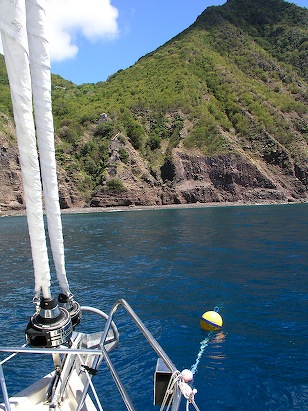
The visitor moorings are a yellow-gold colour with a blue stripe. All other moorings are off limits to cruisers. They are for use by dive boats or local fishing boats and you'll quickly hear from the marine patrol if you tie to the wrong one. The park staff and marine patrol take their job of protecting their pristine waters and coastline very seriously but they are very helpful individuals. Just give them a call on VHF 16 if you have any questions. They'll be very pleased to advise you. The park moorings are maintained and checked regularly by park staff so we felt safe leaving the boat here during our 4-night, 5-day stay in the calm conditions we had.
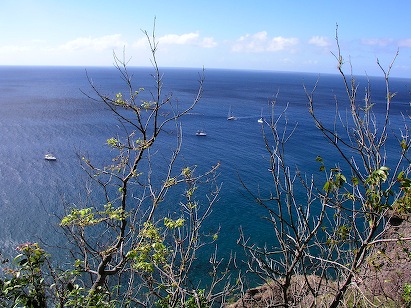
Looking down on the boats on moorings in Ladder & Well's Bay
So what do you do in Saba if you visit by boat? When you get to the harbour at Fort Bay you must first check in with the Harbour master ($20 for our 42 boat) and Marine Park Office ($12 for one week for the 2 of us including use of the mooring – a great deal!) and ask about getting a taxi to town. We had the charming Donna Cain as our taxi driver. Phone 416 6042 (The country code for Saba is 599). Donna has an incredible knowledge of local flora and fauna as well as local history. Her Island Day Tour is great!
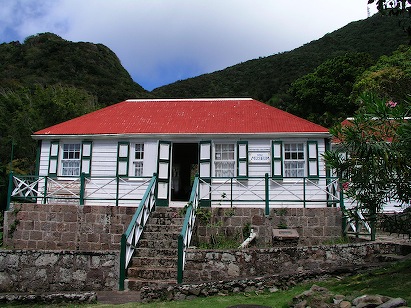
The Saba Museum shows a traditional Saban home
From Fort Bay, the first village you reach after a drive up the S-curving road to the top is strangely called The Bottom. The main town, called Windwardside, is further on up and yes it is on the windwardside. This is where you'll find the Saba Tourist Office, (this site has many useful links) most restaurants, the Saba Conservation Association Trail Office and numerous charming and spotlessly clean guest houses as well as upscale hotels.
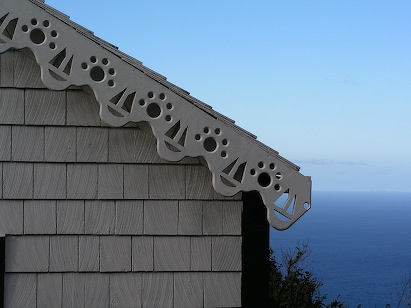
Sailing is a theme throughout the island so we felt at home.
We ended up staying ashore at the Cottage Club during our visit to Saba. We were filming an episode of Distant Shores about Saba (Season 6, episode #70) and it was such a wet dangerous dinghy ride to go back and forth daily from Fort Bay to the boat at the Well's Bay anchorage carrying all our camera and audio equipment we decided it was best to stay ashore, something we rarely do.
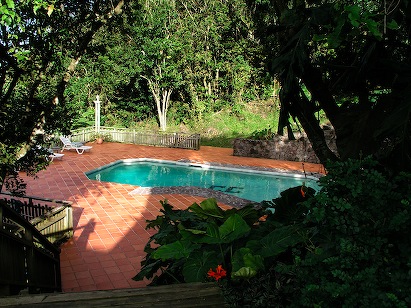
At the cottage club we had a lovely traditional cottage with a stunning view of surrounding countryside including Mount Scenery, the highest peak in the Kingdom of the Netherlands at over 800 meters. The cottage had a bedroom with a king-sized 4-poster bed and a nice kitchen. There was also a swimming pool with a fantastic view of the sea, so nice to relax in after a day of hiking in the rain forest.
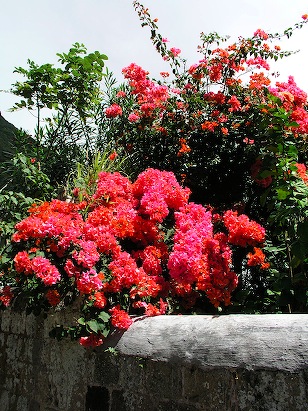
To learn about all the historic trails here, some hundreds of years old, pick up a map at the Trail Office. You can hire a guide for a really informative experience for as little as $45-$60 depending on the size of your group and the difficulty of the trail. We hiked the Santa Cruz trail with Crocodile James who is immensely knowledgeable and entertaining. Paul and I learned loads of stuff about local history, vegetation, and foods from the wild.
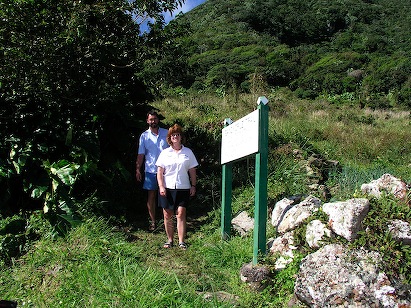
Oh, by the way, although this is a Dutch island, the original settlers were English, Irish and Scottish so few people speak Dutch. English is spoken here with a delightful Irish/Scottish/Caribbean lilt.
I guess you can tell we've really become enchanted with Saba. For the full story on our experiences there check out our upcoming article in the June 2009 of Canadian Yachting magazine which you can read online.
Ladder Bay
Saba, Dutch Netherlands Antilles

We've just had a wonderful week exploring the island of Saba! Never heard of it? Neither had we. But what an undiscovered treasure this place is! Although it's just a short daysail from the busy touristic island of St. Martin/Sint Maarten, 28 nm to the southwest, it is a remote natural paradise. The only visitors to the tiny yet towering 5 sq mile island of Saba (an extinct volcano) are those seeking quiet remote eco-tourist escapes such as divers, hikers, and a few intrepid cruising sailors.
The main reason for this is that Saba is a challenge to get to. Even Columbus didn't stop here when he sailed by the steeply-sided island in 1493. Today there is an airport but looking at the runway which is precariously positioned on a built-up rocky outcrop near the shoreline you understand why it's considered one of the most challenging runways in the world. Luckily they have some of the best pilots flying in here. There are 4 to 5 flights per day and it makes your heart pound to watch the planes take off or land.

Also, there are no good harbours. There are a couple of anchorages but even on good days they are exposed and a bit rolly. We waited for a forecast of calm days with no northerly swells before sailing over. Even then we were glad we could drop our Southerly 42's swing keel to its full 9 feet draft to keep the boat steady in the anchorage. Recently the Saba Marine Park has installed a series of good solid moorings for visiting sailors which you'll find on the west coast in Wells Bay and Ladder Bay as well as a few on the south coast at Fort Bay to the east of the small ferry dock. This has improved things a bit for the cruising sailor but if you're on one of the moorings in Wells or Ladder Bay, the most protected and desirable anchorages, you still face a rough wet dinghy ride to the town quay 2 nm away in Fort Bay.

The alternative is to beach the dinghy on the boulder-strewn beach at Ladder Bay (only on the calmest of days!) and climb “the Ladder”, an 800-step stairway which crawls up the cliffs to the top of the island where “the Road” and the small spotlessly clean villages housing Saba's 1,400 inhabitants are located. This is not advised if you're going to spend any length of time ashore but on a very calm day it is a fun activity to climb The Ladder and experience what the islanders had to do on days of old, before the building of the small harbour at Fort Bay. The Ladder was the only way the islanders could get cargo and passengers off the boats and up to town. Everything – food, furniture and even a bishop – was carried by porters to the top!

The visitor moorings are a yellow-gold colour with a blue stripe. All other moorings are off limits to cruisers. They are for use by dive boats or local fishing boats and you'll quickly hear from the marine patrol if you tie to the wrong one. The park staff and marine patrol take their job of protecting their pristine waters and coastline very seriously but they are very helpful individuals. Just give them a call on VHF 16 if you have any questions. They'll be very pleased to advise you. The park moorings are maintained and checked regularly by park staff so we felt safe leaving the boat here during our 4-night, 5-day stay in the calm conditions we had.

Looking down on the boats on moorings in Ladder & Well's Bay
So what do you do in Saba if you visit by boat? When you get to the harbour at Fort Bay you must first check in with the Harbour master ($20 for our 42 boat) and Marine Park Office ($12 for one week for the 2 of us including use of the mooring – a great deal!) and ask about getting a taxi to town. We had the charming Donna Cain as our taxi driver. Phone 416 6042 (The country code for Saba is 599). Donna has an incredible knowledge of local flora and fauna as well as local history. Her Island Day Tour is great!

The Saba Museum shows a traditional Saban home
From Fort Bay, the first village you reach after a drive up the S-curving road to the top is strangely called The Bottom. The main town, called Windwardside, is further on up and yes it is on the windwardside. This is where you'll find the Saba Tourist Office, (this site has many useful links) most restaurants, the Saba Conservation Association Trail Office and numerous charming and spotlessly clean guest houses as well as upscale hotels.

Sailing is a theme throughout the island so we felt at home.
We ended up staying ashore at the Cottage Club during our visit to Saba. We were filming an episode of Distant Shores about Saba (Season 6, episode #70) and it was such a wet dangerous dinghy ride to go back and forth daily from Fort Bay to the boat at the Well's Bay anchorage carrying all our camera and audio equipment we decided it was best to stay ashore, something we rarely do.

At the cottage club we had a lovely traditional cottage with a stunning view of surrounding countryside including Mount Scenery, the highest peak in the Kingdom of the Netherlands at over 800 meters. The cottage had a bedroom with a king-sized 4-poster bed and a nice kitchen. There was also a swimming pool with a fantastic view of the sea, so nice to relax in after a day of hiking in the rain forest.

To learn about all the historic trails here, some hundreds of years old, pick up a map at the Trail Office. You can hire a guide for a really informative experience for as little as $45-$60 depending on the size of your group and the difficulty of the trail. We hiked the Santa Cruz trail with Crocodile James who is immensely knowledgeable and entertaining. Paul and I learned loads of stuff about local history, vegetation, and foods from the wild.

Oh, by the way, although this is a Dutch island, the original settlers were English, Irish and Scottish so few people speak Dutch. English is spoken here with a delightful Irish/Scottish/Caribbean lilt.
I guess you can tell we've really become enchanted with Saba. For the full story on our experiences there check out our upcoming article in the June 2009 of Canadian Yachting magazine which you can read online.
blog comments powered by Disqus